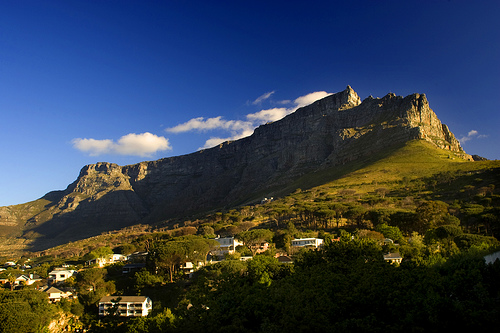ダーウィンの日記1836年6月2日 [ダーウィンの日記]

テーブルマウンテン
ダーウィンの日記(喜望峰; ケープタウン)
[日記仮訳]
(1836年6月)2日[1831年12月27日に英国プリマスを出発してから4年5ヶ月と6日後]
午前中、町[注]を見るために近くの丘まで散歩した。スペイン式の都市の正確さで矩形に設計されている。通りは整然としていて砕石舗装されており、そのいくつかは両側には樹々の列がある。家屋は全て白い漆喰塗りできれいに見える。いくつもの些事においてはこの町は外国風ではあるが、日に日に英国的になりつつある。町には最下層の者たちを除いては何らかの英語を話さない居住者はほとんどいない。この英国化の容易さにおいてこの植民地とモーリシャスのそれとの間には大きな開きがあるように思われる。だが、これは英国人の人望によるものではない。オランダ人は、モーリシャスのフランス人と同様、英国支配によって莫大な程度の利益を得ているにも関わらず、こちらの国民全体を全く嫌っているからである。この地全体において、オランダ人や他の者たちに向けての物の値段は一律だが、英国人に対してはずっと高い値段が付けられる。そうではあっても、最近幾人かのオランダ人はその子息達を農業の適正なやり方を学ぶために英国に送ったのである。
[注] ケープタウン。
文明化された世界の全ての断片、南半球においてそういう所を私たちは訪ねて来たのであったが、そういう所は全てがすくすく育っているようであり、小さな英国の胚芽が至る所に芽生えている。ケープ植民地は、ほどほどの肥沃さを持った土地に過ぎないが、とても繁栄した状態にあるようだ。ある面ではニュー・サウス・ウェールズ[注]と同じようなことで苦しんでいる。つまり飲料水の流通の欠如であり、そして内陸部が海岸から高い山脈で隔てられているということである。
[注] オーストラリア。
この地には石炭がなく、かなりの距離の所以外では木材が全く不足している。獣皮、獣脂およびワインが主な輸出品であり、最近ではかなりの量の穀物もそうである。農民は牧羊にも関心を払いつつある。これはオーストラリアからの示唆による。植民地となって33年のヴァン・ディーメンス・ランド[注]にとっては、そこから1651に設立されたここまでヒツジが輸出されたということは小さからぬ勝利なのである。
[注] タスマニア。英国人による最初の入植は1803年に行われた。
ケープタウンにおける現在の住民の数は約1万5千人で、植民地全体では有色の人々も含めて20万人であろうと云われている。多くの相異なった民族がここでは混じりあっている。ヨーロッパ人はオランダ人、フランス人および英国人、そして他の部分からの寄せ集めの人々である。マレー人は東インド諸島から連れてこられた奴隷達の後裔であるが、多くの人口を形成している。彼等は結構な人々であり、円錐形のかぶり物[注]によって見分けられる。それは円形の茅葺きの小屋の屋根のようである。あるいはま頭に付けた赤いハンカチによっても見分けられる。黒人の数はそれほど多くはない。ホッテントット[*注]は、ここで良くは扱われていない先住民[aboriginals]なのだが、さらに小さな割合でしかいないと私は思う。
[注] 菅笠(すげがさ)のことであろう。
[*注] 現在ではコイコイ人(Khoikhoi)と呼ばれる。
ケープタウンで初めて訪れる者の眼をうつ最初のものは、数多くのウシの牽く車である。幾度も18頭の、そして24頭のもあると聴いているが、牡牛が一組にくびきでつながれているのを私は見た。これらの他に至る所で馬車を4頭、6頭、および8頭のウマが曵いて小走りに進んでいる。
名高いテーブル・マウンテンに私はまだこれまで触れなかった。この水平に層状となった砂岩の大きな塊は町の背後すぐ近くに3500フィート[1067m]の高さに立ち上がっており、その上部は絶壁をなしていて大抵のところで雲の領域に達している。このように高い山が、台地の一部を形成するのでなく水平の層で構成されているというのは稀なことに違いないと私は考えざるを得ない。これはとても特異な景観をなしており、ある観点からは壮大な性格のものである。
[地図1] ケープタウン..
View Larger Map
[地図2] テーブル・マウンテン..
View Larger Map
[画像] テーブル・マウンテン

画像出典: http://www.panoramio.com/photo/387409
[日記原文]
2nd
In the morning I walked to a neighbouring hill to look at the town. It is laid out with the rectangular precision of a Spanish city; the streets are in good order & macadamized, & some of them have rows of trees on each side;
the houses are all white-washed & look clean. In several trifling particulars the town has a foreign air; but daily it is becoming more English.
There is scarcely a resident in the town, excepting among the lowest order, who does not speak some English; in this facility in becoming Anglefied, there appears to exist a wide difference between this colony & that of Mauritius. This however does not arise from the popularity of the English, for the Dutch, as the French at Mauritius, although having profited to an immense degree by the English government, yet thoroughly dislike our whole nation. In the country universally there is one price for a Dutchman, & another & much higher one, for an Englishman; nevertheless some few of the Dutchmen have lately sent their sons to England to learn a proper system of agriculture.1
All the fragments of the civilized world, which we have visited in the southern hemisphere, all appear to be flourishing; little embryo Englands are hatching in all parts. The Cape Colony, although possessing but a moderately fertile country, appears in a very prosperous condition. In one respect it suffers like New South Wales, namely in the absence of water communication, and in the interior being separated from the coast by a high chain of mountains.
This country does not possess coal, & timber, excepting at a considerable distance, is quite deficient. Hides, tallow & wine, are the chief export, & latterly a considerable quantity of corn.
The farmers are beginning also to pay attention to sheep grazing, a hint taken from Australia. It is no small triumph to Van Diemens Land, that live sheep have been exported from a colony of thirty three years standing to this one, founded in 1651. —
In Cape town it is said the present number of inhabitants is about 15,000, and in the whole colony, including coloured people, 200,000. Many different nations are here mingled together; the Europæans consist of Dutch, French & English, & scattered people from other parts. The Malays, descendants of slaves brought from the East Indian archipelago, form a large body; they appear a fine set of men; they can always be distinguished by conical hats, like the roof of a circular thatched cottage, or by a red handkerchief on their heads. —
The number of negroes is not very great, & the Hottentots, the ill treated aboriginals of the country, are, I should think, in a still smaller proportion.
The first object in Cape town which strikes the eye of a stranger, is the number of bullock waggons; several times I saw eighteen & heard of twenty four oxen being all yoked together in one team;2 Besides these, in all parts waggons with four, six, & eight horses in hand, go trotting about the streets.—
I have as yet not mentioned the well known Table mountain; this great mass of horizontally stratified sandstone rises quite close behind the town to a height of 3500 feet; the upper part forms an absolute wall, often reaching into the region of the clouds. I should think so high a mountain, not forming part of a platform & yet being composed of horizontal strata, must be a rare phenomenon; it certainly gives the landscape a very peculiar, & from some points of view, a grand character. —
1 Followed by a deleted passage: 'One young man, who had just returned from Norfolk, proposed to his father to drain a large shallow lake; the Father with difficulty consented to so strange an idea, as to convert a lake into a cornfield. The plan, as might be expected, succeeded well, but after the three first years the ground was so overrun with weeds, that the old gentleman perceived with joy, that the new fashion seemed likely to fail. The son however soon closed the drain, flooded the land, & so killed the weeds; the old gentleman was amazed at these unheard of expedients,but the next year reaped a fine crop of corn.'
2 Followed by deleted words: 'the line looks as long as if all the cows in a field had been caught & tied together for sport.'

["ダーウィンの日記(III)"について]
ここで扱っているのはダーウィンがビーグル号で航海に出ている時期の日記です。訳文は私的な研究目的に供するだけの仮のものです。普通は全文を訳します。また、ダーウィンが日記を書いた当時の世界観を出来るだけそのままにして読む事を念頭に置きますので、若干の用語の注釈を除いては、現代的観点からの注釈は控え気味にしてあります。
[日記原典] Charles Darwin's Beagle Diary ed. by R.D.Keynes, Cambridge U.P., 1988.
1835年1月1日より前のダーウィンの日記へはページ左のリンク集が入り口となります。
冒頭画像出典:http://www.flickr.com/photos/aperture_photo/2987510342/




いつも興味深く拝見しています。
by ナカムラ (2009-11-18 01:33)
ナカムラさん..
コメントありがとうございます。
またよろしくおねがいします。
by さとふみ (2009-11-18 05:37)
ご訪問 & nice ありがとうございました。
by ビアンカ (2009-11-19 15:12)
南アフリカというと、アパルトヘイトという言葉しか思い浮かばない程、ほとんど何も知らないんですが、ワールド・カップも有るコトですし、興味津々です。
by SAKANAKANE (2009-11-22 01:45)